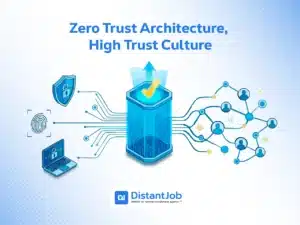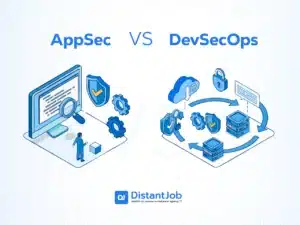There is a very common term in software development called code futureproofing. This involves building code today to support future technologies and requirements. There are debates about whether futureproofing is a good thing. Does trying to anticipate the future add complexity, cost, and unnecessary features to the development process, or is it a smart way to plan for future needs?
In this article, we break down the pros and cons of code futureproofing, helping you decide whether futureproofing is a valuable feature in software development or just an expensive bug.
What is Code Futureproofing?
Code futureproofing is the practice of writing code that is loosely coupled, allowing for easy modification in the future. These changes can be in scale architecture, requirements, technology stack, or integration.
Suppose you’re futureproofing a code to enable it to interact with evolving technologies. In that case, you would modularize your code so that each part of your application can interact independently of the app’s language and technology.
A good example would be using JSON or XML to pass data between different parts of the app. Regardless of how technology evolves, it will likely be able to handle these standard data formats.
Does Code Futureproofing Make Sense When Working with Remote Dev Teams?
Absolutely! Code futureproofing is essential when collaborating with remote development teams. When you have a team of developers scattered across different locations, time zones, and even cultures, collaboration can be a bit tricky.
Misunderstandings, miscommunications, and a lack of shared context can easily creep in, making it harder to maintain a consistent vision and approach to the codebase.
That’s where futureproofing comes in handy. By putting in the effort to write clean, well-documented, and modular code from the start, you are creating a solid foundation. Any developer, regardless of location or background can easily understand and maintain it.
Think about it this way: if your code is a mess with no clear structure or documentation, it is going to be a nightmare for a new developer (or even yourself in a few years) to jump in and make additions. But if your code is well-organized and follows best practices, the reverse is the case. Anyone on the team can pick it up, understand it, and work with it.
Futureproofing your code is about investing time and effort upfront to save yourself (and your team) lots of headaches down the road. That investment becomes even more valuable when you work with a remote dev team. It helps bridge the gap and challenges that come with distributed collaboration.
Should You Future Proof Your Code?
If you want to build software that is impervious to changes and stands the test of time, yes, you should futureproof your code. But that’s not the only reason you should. You should also adopt this practice because it guarantees the following.
1. Longevity of Your Codebase
No one wants to constantly rewrite or refactor their codebase every time a new technology trend emerges. With a modular and loosely coupled architecture, you can make incremental updates and enhancements without disrupting the entire system.
Plus, clear documentation and abstraction make it easier for new team members to understand the codebase, even years down the line.
2. Scalability
Speaking of scalability, futureproofed code is like a flexible foundation that can grow with your project’s needs. Modular components and loose dependencies allow you to scale horizontally by distributing parts across multiple servers and environments. And if you need to scale vertically, those abstraction layers let you swap out underlying implementations with more performant alternatives without breaking anything.
3. Collaboration and Knowledge-Sharing
Now, let’s talk about the real MVP for remote teams: collaboration and knowledge-sharing. Consistent coding standards and thorough documentation facilitate effective communication among dispersed team members.
Modular architecture reduces merge conflicts when working in parallel. And those clear abstractions? They make it easier for everyone to understand and work on different parts of the codebase, promoting seamless collaboration.
4. Onboarding and Team Mobility
With future-proofed code, onboarding and team mobility are also a breeze. Imagine a new developer joining your remote team—well-documented and extensible code means they can hit the ground running. Also, if they need to switch between components or projects, modular code makes that transition smoother.
5. Technology Evolution
With a future-proof codebase, you can adapt to technology advancement more seamlessly. As new frameworks, libraries, or tools emerge, modular architecture allows you to integrate them without causing chaos.
This flexibility enables your application to stay up-to-date with the latest advancements, ensuring that your project remains relevant and competitive. It also enables your team members, no matter their location or their tech stack, to collaborate and contribute to the project effortlessly.
6. Long-term Maintenance
Even as requirements change and team members come and go, future-proofed code with solid design principles keeps your codebase stable and adaptable. Regular testing and refactoring practices keep technical debt at bay, reducing the risk of issues during maintenance cycles.
4 Disadvantages of Futureproofing Your Code
Despite its positives, code futureproofing has drawbacks, including overengineering, cost-intensive, a steep learning curve, and futureproofing for the wrong things. Let’s break them down below.
1. Overengineering
Overengineering is when you design software to be more complex or have more features than necessary. When you are trying to anticipate and account for every possible future scenario, it is easy to get carried away and end up with an overly complicated codebase.
This can make things harder to understand and maintain, which is the opposite of what you want — especially when working with a distributed team.
Imagine trying to onboard a new developer to a codebase that has been futureproofed to the extreme — it could be a nightmare!
2. Resource-intensive
A future-proofed codebase doesn’t come cheap. It takes a lot of development time and computational resources. All those abstractions, interfaces, and extensibility points don’t come for free.
They require extra effort to design and implement, which can slow development cycles. And when you’re working with remote teams across different time zones, coordinating and aligning on these architectural decisions can be even trickier.
Moreover, overengineered, future-proofed code can have higher runtime overhead and consume more memory. This might not be a big deal for smaller projects.
But when building large-scale distributed systems with remote teams contributing from various locations, those inefficiencies can add up — potentially impacting performance and scalability.
3. Futureproofing for the Wrong Things
There’s also the risk of futureproofing for things that might not actually become necessary. It is hard to predict how requirements or technologies will evolve. If you guess wrong, you might end up with a codebase that is overly complicated and difficult to work with. And it still won’t meet the future needs.
Plus, when working with a remote team, aligning everyone on the right future-proofing strategies can be tricky due to underlying communication barriers.
4. Learning Curve
Futureproofed code can eventually become easy to maintain. However, it can be initially challenging to learn and understand — especially for junior developers or new remote team members. Those abstractions, patterns, and architectural decisions can make the codebase harder to navigate and wrap your head around at first.
Conclusion
Code futureproofing allows you to prepare your software for future changes. Organizations that adopt this practice will be better equipped to adjust to evolving market demands and emerging technologies.
However, the success of your code futureproofing endeavors will heavily depend on the talent at your disposal, especially in a remote environment.
That’s why you need to work with us.
At DistantJob, we connect you with the right global talent to ensure your projects are in capable hands. We provide ongoing support throughout the hiring process, from headhunting to handling all the HR hassle. We focus on your company hiring the right people to build everlasting relationships.
Ready to take the next step? Let’s talk.





